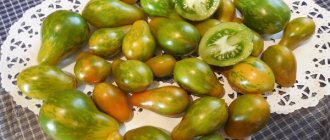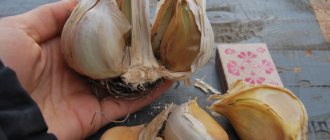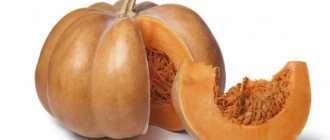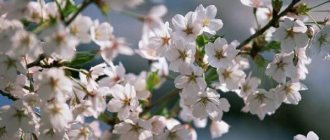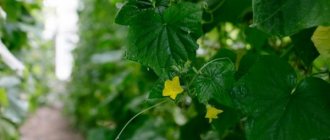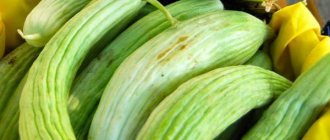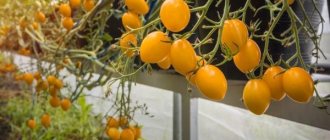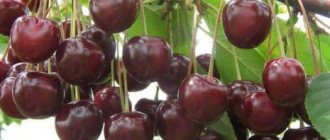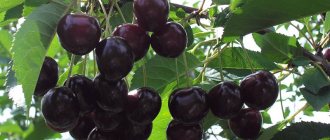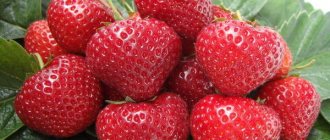Cherry appearance
It is difficult to determine the variety by the appearance of the plant - Pamyat Enikeev has no special signs. The culture can be distinguished at the time of flowering (the inflorescences resemble tiny glasses) or after the fruits appear.
Tree
The height of the tree is up to 3 m. The bark of a young plant is dark gray, becoming brown with age. The crown is lush, fruiting occurs on branches collected in bunches.
Fruit
The fruits are large, with good care they grow up to 5 g. The taste of the berries is reminiscent of cherries. In the southern regions, cherries are sweeter, although climatic conditions do not affect the size of the fruit.
See also
Description and characteristics of the cherry variety Evening Dawn, history and cultivation rulesRead
History of selection and region of breeding
This is the result of the collective work of five employees of the Institute of Horticulture of the State Scientific Institution VSTISP, located in Moscow.
The authors are Doctor of Biological Sciences, specialist in the study of stone fruit crops Kh.K. Enikeev, agronomist-pomologist S.N. Satarova, A.I. Evstratov, V.S. Simonov, A.M. Mikheev.
In 2001, it was approved for use in the Bryansk, Moscow, Ryazan, Kaluga, Vladimir, Ivanovo, Smolensk, and Tula regions.
In this region, varieties such as Morozovka, Zhivitsa, Turgenevka, Kharitonovskaya, and Shokoladnitsa also grow successfully.
This is the result of the collective work of five employees
Enikeev’s memory is the product of the work of breeders at the Moscow station. The variety received its name thanks to one of the creators. The crop was obtained by crossing two varieties - Korinka and Zhukovka. After 2000, Memory of Enikeev was distributed among different regions of Russia, where cherries passed the tests with dignity and quickly gained popularity.
https://www.youtube.com/watch?v=zNzTMARaGnQ
The seeds are easily separated from the pulp; the drupes are quite small.
The Pamyat Enikeev cherry tree itself is no different from its relatives - a lush crown, large leaves. The root system is compact, which allows trees to be planted at a short distance.
Characteristics of the variety
Enikeev's memory is self-fertile - pollinators are not needed. Peak fruiting is the 7th year after planting. Ripening occurs in mid-June.
Tolerates drought and cold well. The shoots and buds are frost-resistant, so even spring frosts will not harm the plant.
Productivity
Proper care allows you to get up to 15 kg of berries from an adult plant. Dry summers, lack of watering and fertilizing will affect the number of fruits - no more than 10 kg.
Climate Resilience
Memory Enikeev tolerates frosts well; only young plants need covering. Heat has a detrimental effect on trees, so regular watering will be necessary.
Advantages and disadvantages
The main advantages of culture include:
- sustainability;
- unattractive to insects;
- rare diseases;
- productivity.
Disadvantage: Frequent pruning will be required. Cherry has a tendency to form basal shoots, which will have to be removed regularly .
Reviews from gardeners
“This variety has a big advantage - ripe berries do not fall off the branches. But the simultaneity of their maturation is rather a minus than a plus for me. On the one hand, cherries can be collected at one time, which is very convenient if you do not live near the site. But, for example, I have three such trees and all of them have good yields.
“Cherry of this variety has never hurt me. I carry out the usual antifungal treatment of all trees in the spring and clean them in the fall, this is enough. On the topic of prevention, I was given good advice: add copper or iron sulfate to the lime to whiten the trunk. This works immediately against both pests and fungi.”
“The spring before last, the garden was hit by a late frost, and as a result, we lost some of the berries and fruits. Enikeev’s memory was just one of those trees that managed to set fruit and produce a harvest. I would like to note that this tree will not be the first to contract the fungus in the garden, but if another cherry tree begins to spread the infection, then yes, it may catch it. So it’s not so much that you need to monitor it yourself, but rather the less resistant varieties, if you have any.”
First of all, owners of small plots cultivating cherries for their own needs should consider this self-fertile variety as a growing option. The tree will give a good harvest, even if there is no room for planting other cherries in the garden. If it is possible to provide it with pollinators, cherries of this variety can show greater productivity. The exception is areas located in lowlands. In this case, it is worth abandoning attempts to cultivate Enikeev’s Memory.
Cherry agricultural technology.
Features of planting and growing.
1. General information about cherries. Useful properties of cherries.
Cherry berries have been widely used in folk medicine since ancient times. Cherry is a dietary product; it increases appetite and improves the digestion process. Cherry fruits have a slight laxative effect.
Cherry has antiseptic and anti-inflammatory properties. Cherry juice quenches thirst at elevated temperatures. Traditional medicine recommends eating a kilogram of fresh cherries a day for a month, washing them down with 7-8 glasses of milk - this helps with arthritis and sclerosis. Cherry has a beneficial effect on the central nervous system; its decoction was used for mental illness and epilepsy.
The coloring pigment anthocyanin is highly digestible, as it is distributed throughout the fruit pulp. There is a lot of cherry fruit and coumarin, a substance that reduces blood clotting. This feature of cherries allows it to be used to prevent a number of complications of arterial atherosclerosis, and the successful combination of vitamins C, B1, B6, iron, magnesium, cobalt, and pigments in cherries is used to prevent and treat anemia.
Cherry - contains hematopoietic microelements: iron, copper, cobalt, which makes it possible to use it for anemia. Pectin substances help remove nitrogenous waste from the body. Cherry pulp contains bactericidal substances. Cherry juice is used for mental illness, arthritis, as a mild laxative, expectorant, thirst quencher and appetite enhancer.
Ascorbic acid in combination with P-vitamin active tannins and cherry pigments tone, strengthen blood capillaries, reduce high blood pressure, and increase the body's resistance to adverse effects, in particular, to increased background radiation. Eating cherries reduces the frequency and severity of heart attacks.
2. Choosing a place for cherries.
— Cherry requires a well-lit place. Otherwise, a decrease in the sugar content of the fruit and a general decrease in yield are possible.
— Cherry is far from the most frost-resistant crop. In this regard, it is recommended to plant next to country houses (between a barn and a bathhouse, a house and a fence). The best place for cherries is sunny, closed on the north side by a brick wall, which, when heated, will not only protect from cold winds, but also damage the tree.
— Cherry does not tolerate stagnant water. If there is a possibility of flooding on the site, the tree should be drained if possible or planted on a hill. Otherwise, the tree will have poor development or even death. The groundwater level should be at least 1.5-2 m.
— Cherry grows best on light sandy or loamy soils. On heavy clay or sandy soil, cherries most likely will not develop. In this case, a good landing hole is required. The acidity of the soil should be close to neutral: pH 6.5-7.0.
Read more: Grape varieties alphabetically by vineyard names
3. Cherry planting and care.
— Planting of seedlings can be carried out exclusively in spring (for bare root plants), and from spring to September (for containerized plants).
— Cherry seedlings should not be buried when planted in the ground. The root collar (the place where the root enters the trunk) should be 5-7 cm above ground level.
— When buying a seedling in the spring, you can immediately prune the branches. You can't cut the roots. The more of them a young tree has, the faster it will take root. The roots can only be straightened.
— Almost all varieties of cherries growing in the Moscow region are considered self-sterile, that is, they need pollen from another plant to set fruit. Accordingly, you should keep this in mind and if you or your neighboring plot does not have another tree (another variety of cherry), you should purchase it immediately.
— The feeding area of one cherry tree depends on the rootstock: for vigorous rootstocks - 12 sq.m., for medium-growing rootstocks 9 sq.m.
— When planting cherries, either organic fertilizer (horse humus or humus), potassium chloride - 20 g, superphosphate 30-40 g are placed in the planting hole.
Further feeding. Application of mineral fertilizers before flowering: urea (10 g), potassium chloride (15 g), superphosphate (25 g) per 10 liters of water.
Fertilizers are applied based on 1 sq.m of fertilized tree area. Ammonium nitrate (15-20 g), superphosphate (30-40 g), potassium (10-12 g).
Almost all types of soil under cherry trees require liming. Lime is applied once every 5-6 years in the form of dolomite flour, ground limestone, etc. The application rate depends on the type of soil and ranges from 300 to 500 g. The minimum dose is applied on light soils, and the maximum on heavy soils.
Autumn fertilizing should be WITHOUT nitrogen content. On rich lands, fertilizing should not be done often, but on poor, sandy soils, fertilizers must be applied annually.
— In the first year after planting, it is recommended to cut off 80-100% of the flowers. This is necessary for better survival of the tree. In the future, it is necessary to pick off half of the crop at the greenfly stage - only the established fruit, several centimeters in diameter. This operation is called crop rationing.
— Watering cherries should be carried out 4-5 times a month at the rate of one bucket of water per adult tree, twice a day (morning and evening). Good watering is very important in the period June-July, when fruiting occurs, and at the same time flower buds are laid on the tree, forming the next year's harvest.
If there is a lack of moisture during this period, crop losses are possible both in the current and next year. Watering should be completed in August; otherwise, protracted growth of shoots may result, which can negatively affect the winter hardiness of the tree. However, in a dry year, it is necessary to continue watering so that the tree is saturated with moisture.
— Cherry has a tendency to form basal shoots. It should be cut close to the ground, since it wastes a large amount of nutrients, and there is almost never a harvest.
— Cherry is far from the most frost-resistant crop. In order to protect a young tree from early and severe frosts and snowless winters, it is recommended to mulch with horse humus in the area around the trunk, and also wrap the trunk with covering material or nylon tights (the material must allow water and air to pass through;
— To combat pests such as mice or hares, use the above-mentioned tights, or better yet, a special rodent net.
— A tree trunk circle is required when growing cherries. No plants should be planted in it; it must be kept free of weeds; constantly loosen. If desired, you can separate the tree trunk area from the lawn with a border strip (you cannot use iron sheets or concrete products for these purposes, as in the photo). To improve the winter hardiness of the tree in autumn, it is possible to mulch with horse humus (layer 5 cm thick).
4. Cherry pruning (briefly).
With proper pruning, you can not only regulate the tree’s yield, sugar content, and fruit size, but also save it from diseases.
— When planting, the branches of a young cherry seedling are cut off by one third. This will help him start establishing a crown faster.
Planting and care
Planting is no different from planting other fruit crops. The main thing is to choose a sunny area without drafts or strong wind gusts.
Landing
Plant in a pre-prepared soil mixture - a combination of turf, humus, and river sand. On poor soils, add compost and peat. On sandstones, add clay to the composition.
Watering and loosening
Watering is carried out as needed. In summer - once a week. For an adult tree - up to a bucket of water. Before adding liquid, it is recommended to carry out loosening, while simultaneously removing weeds.
Trimming
In the fall, carry out drastic pruning to form the crown - remove side shoots and thickened branches. In the spring, it is recommended to carry out sanitary treatment - cut out shoots that have frozen over the winter.
Top dressing
It is recommended to use rotted organic matter as a top dressing. It is not necessary to prepare solutions - in the fall, spread a nutrient layer around the trunk and sprinkle with soil. Melt water will continue the process and send useful elements into the soil.
Preparing for winter
Only wrap young plants before wintering. In harsh climatic conditions, also wrap up. Use spruce branches, special agrofibre, burlap.
See also
Description of the Shy cherry variety and fruiting characteristics, growing rulesRead
Prevention and treatment of coccomycosis
Coccomycosis is a disease that affects Enikeev’s Memory quite rarely. For prevention, it is recommended to use copper sulfate (spraying before the buds appear). After flowering, apply “Chorus”, “Strobe”. Remove affected shoots completely and burn immediately.
Description of the fruit
The fruit of the Pamyati Enikeev cherry variety is large. It has a round and slightly elongated shape. The average weight of one berry with a seed is 4.5-5 g. The color of the ripe fruit is dark red on the outside and on the cut. The pulp is dense, like a cherry, but juicy.
The bone is oblong and large. It separates easily from the pulp when pressed. The average weight of a drupe is 0.4 g. The peduncle is long and massive. Ripe berries can be removed effortlessly using a dry method.
The cherry flavor does not have a distinctly noticeable acidity. It vaguely resembles a cherry.
The fruits of the Pamyati Enikeev variety are used in cooking for the production of jam, confitures and juice. Prepared from juice:
- marmalade;
- marshmallow;
- jelly.
The jam turns out moderately dense. These cherries can be used to make dried fruits and candied fruits. The treats turn out fragrant.
From the fruits you can prepare compotes, liqueurs and wine, which will be distinguished by their aroma and rich color. Cherries of the Pamyati Enikeev variety reach their maximum yield after five years of age.
Diseases and pests
Another disease that affects the crop is moniliosis.
Using chemicals is the only way to save the plant. Spraying is carried out with copper-based products. Pests almost never settle on cherries, but it is recommended to use insecticides and folk remedies for preventive purposes even before flowering. Memory Enikeev is a variety that will not cause any trouble and will reward you with a harvest of delicious berries for little effort. The main thing is to follow the rules recommended by agricultural technology, add the required amount of moisture, do not refuse fertilizing, and monitor for diseases and pests.
Varieties in Memory of Voronchikhina and Memory of Vavilov
In addition to the variety described, gardeners are well aware of Pamyati Voronchikhina, a “fresh” hybrid bred in Rossoshi, at the zonal station, at the turn of the century. It has large, almost black fruits. Its trees are vigorous, and ripening occurs in the middle period.
Cultivated cherry trees require care - spring pruning, spraying, fertilizing and autumn whitewashing of trunks and branch bases. Loosen the soil in the garden shallowly. In the crown projection, it is permissible to do this to a depth of 8 centimeters, and further beyond it, where there is no risk of touching the roots, they dig up to 20 centimeters.
Cultivated cherry trees require care - spring pruning, spraying, fertilizing and autumn whitewashing of trunks and branch bases. Loosen the soil in the garden shallowly. In the crown projection, it is permissible to do this to a depth of 8 centimeters, and further beyond it, where there is no risk of touching the roots, they dig up to 20 centimeters.
With careful care, the variety will reward you with a good harvest of tasty and healthy berries. It is a good choice for growing in the regions in which it is zoned.
Description
The fruits are medium to large in size, wide, heart-shaped. Both their skin and pulp are dark red in color and have a delicate texture with a lot of juice. The taste is sweet and sour, dessert, which makes it possible to consume cherries fresh. Tasters rate it with a high score of 4.8 points.
The seeds are easily separated from the pulp. Some sources call them large, while other nurseries call them small. The stalks are torn off with a dry tear. The drupes ripen early and quickly, in the second or third decade of July. They stay firmly on the branches without falling off.
The yield is average, 8-10 kilograms per tree, with good agricultural technology. The purpose is universal; cherry preparations are considered one of the most delicious. Preserves and jams, juices and liqueurs, freezing and drying - these are ways to preserve a valuable product for many months.
The trees are weak-growing. The shape of the crown is elongated, pyramidal. The leaves are dark green, matte. Fruiting occurs according to the mixed type.
a brief description of
| Cherry | dark red |
| 3m | |
| 4,8 / 5 | |
| Size | large |
| 8-15 kg | |
| Term | end of June |
| high | |
| average |
